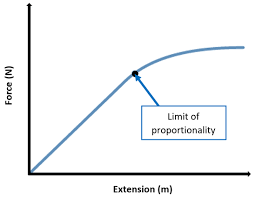Forces and Elasticity
Stretching, compressing or bending transfers energy
- When you apply a force to an object you may cause it to stretch, compress or bend
- To do this, you need more than one force acting on the object, otherwise the object would simply move in the direction of the applied force instead of changing shape
- An object has been elastically deformed if it can go back to its original shape and length after the force has been removed
- Objects than can be elastically deformed are called elastic objects
- An object has been inelastically deformed if it doesn’t return to its original shape and length after the force has been removed
- Work is done when a force stretches or compresses an object and causes energy to be transferred to the elastic potential energy store of the object. If it is elastically deformed. ALL this energy is transferred to the object’s elastic potential energy store
Extension is directly proportional to force
If a spring is supported at the top and then a weight is attached to the bottom, it stretches
- The extension of a stretched spring is directly proportional to the load of force applied
- F=ke
- The spring constant depends on the material that you are stretching-a stiffer spring has a greater spring constant
- The equation also works for compression
But this stops working when the force is great enough
There’s a limit to the amount of force you can apply to an object for the extension to keep on increasing proportionally
- The graph shows force against extension for an elastic object
- There is a maximum force above which the graph curves, showing that extension is no longer proportional to force. This is known as limit of proportionality and is shown on the graph at the point marked P
- You might see graphs with these axis the other way round-extension force graphs. The graph still starts with a straight part, but starts to curve upwards once you go past the limit of proportionality, instead of downwards
